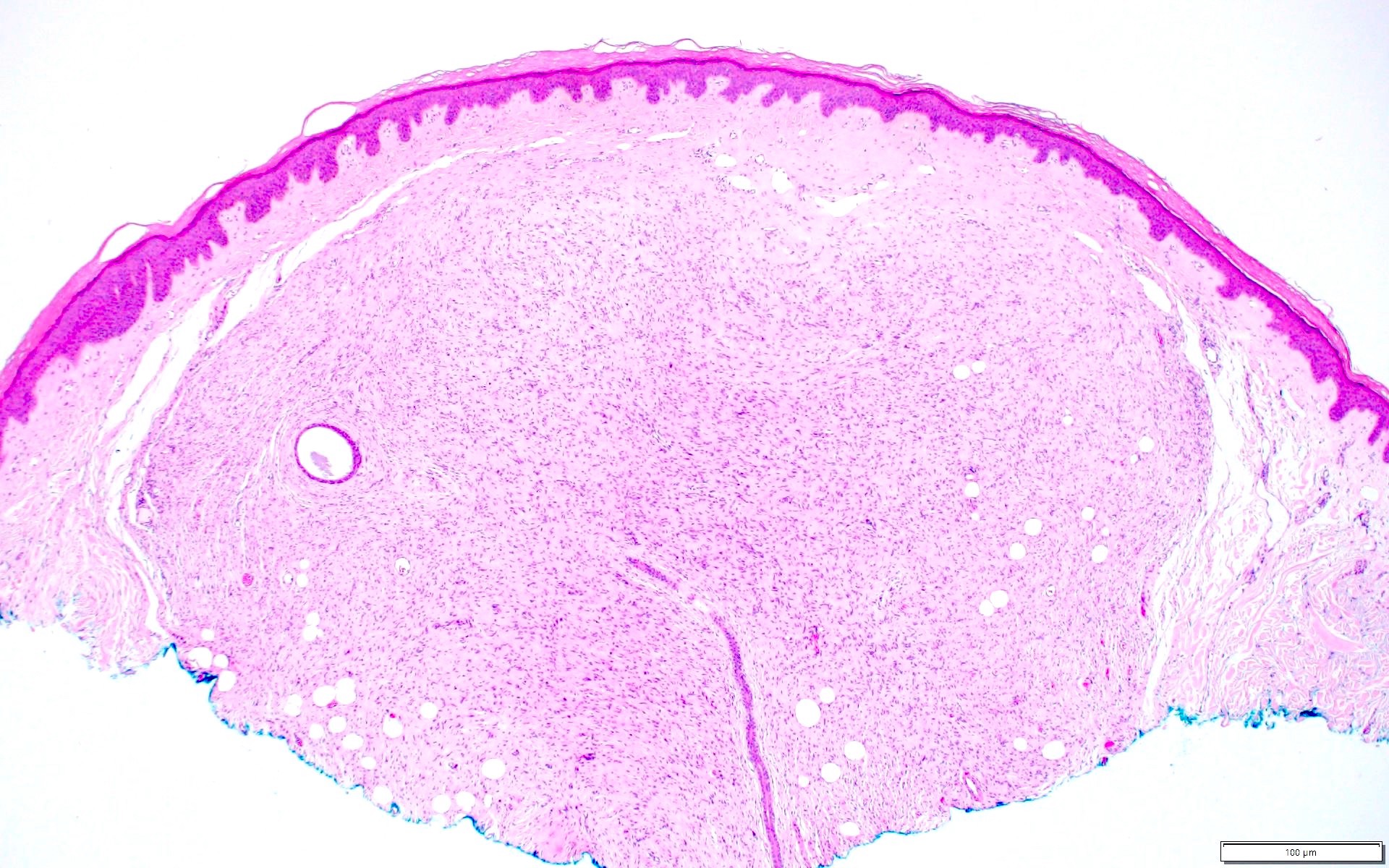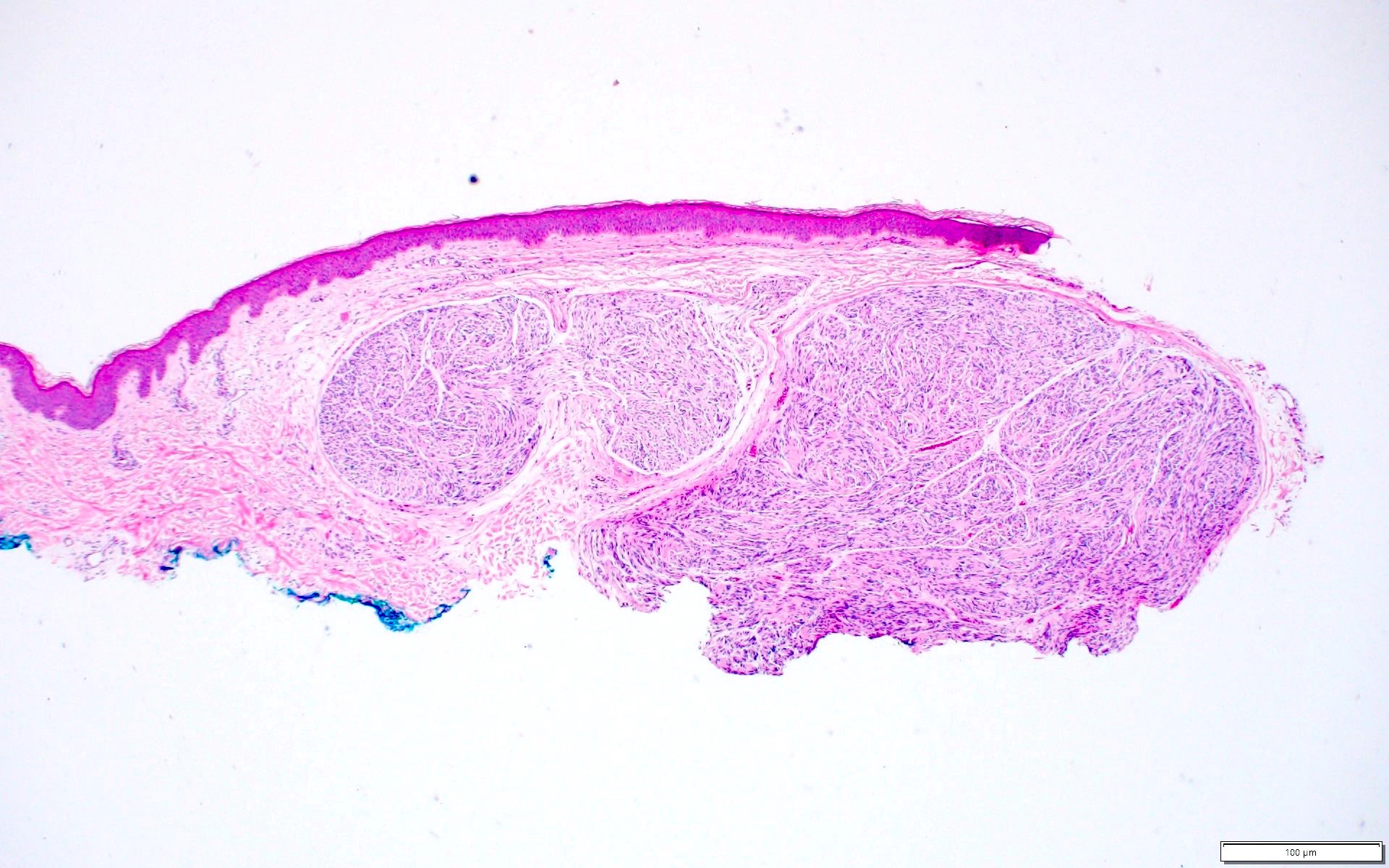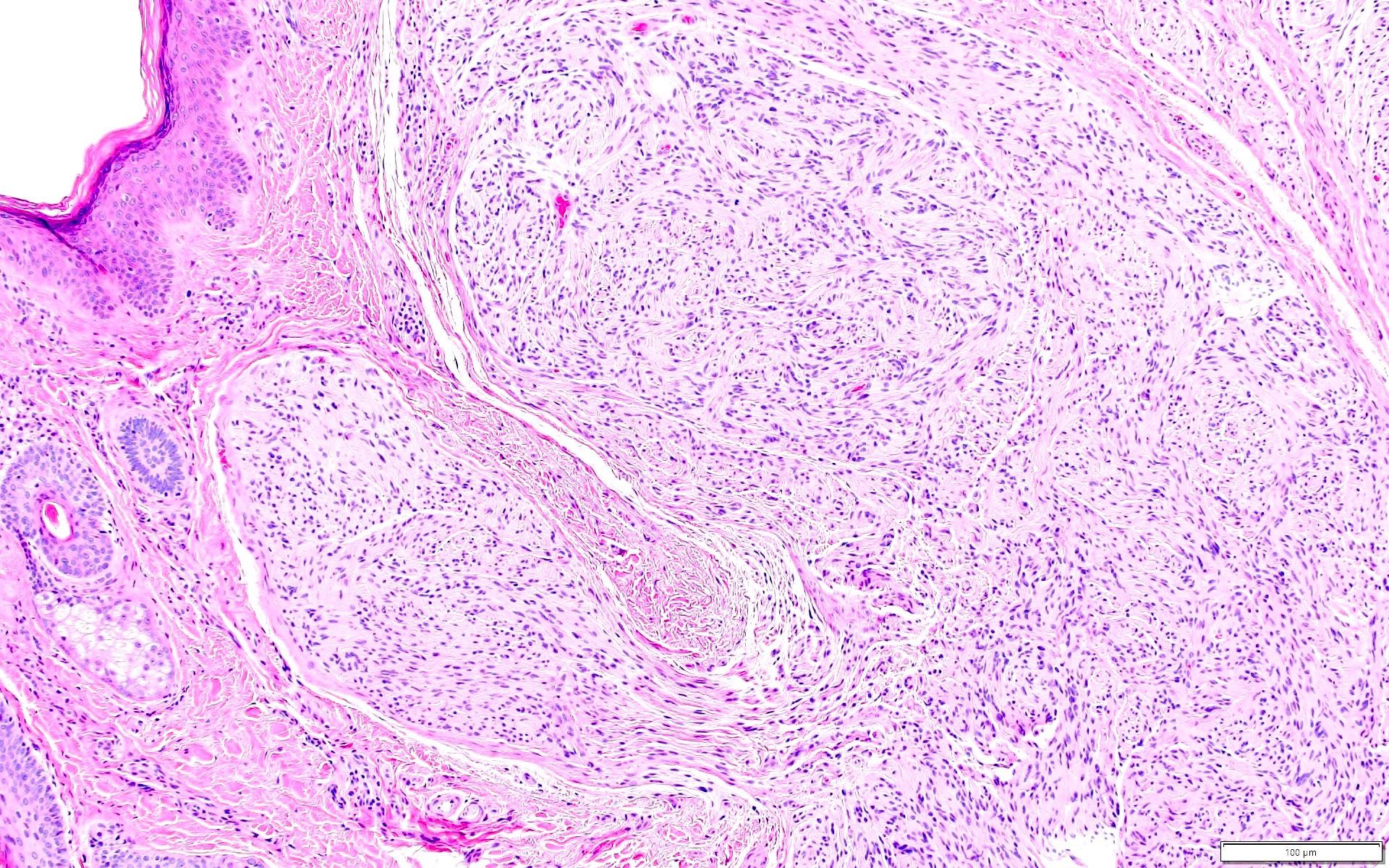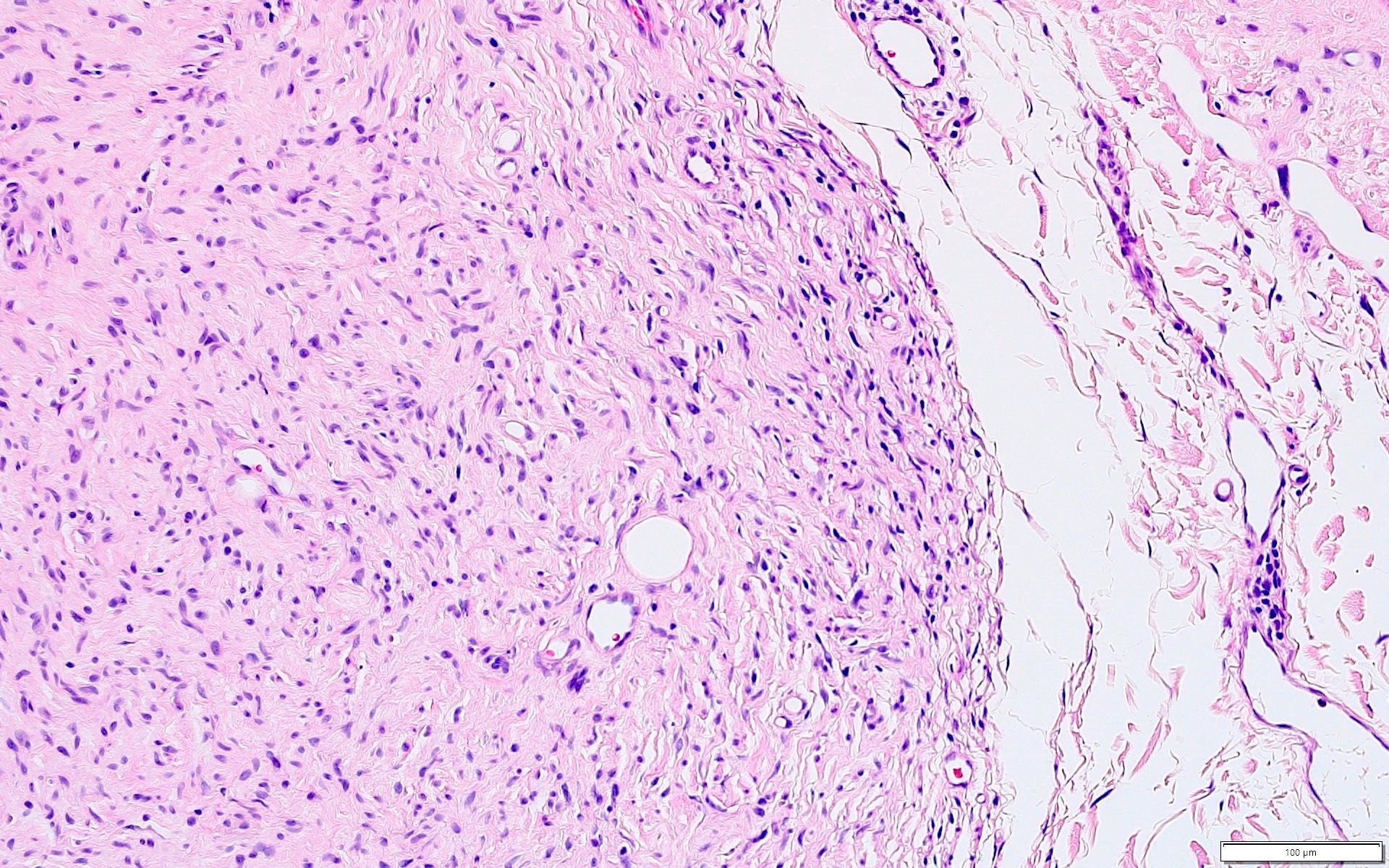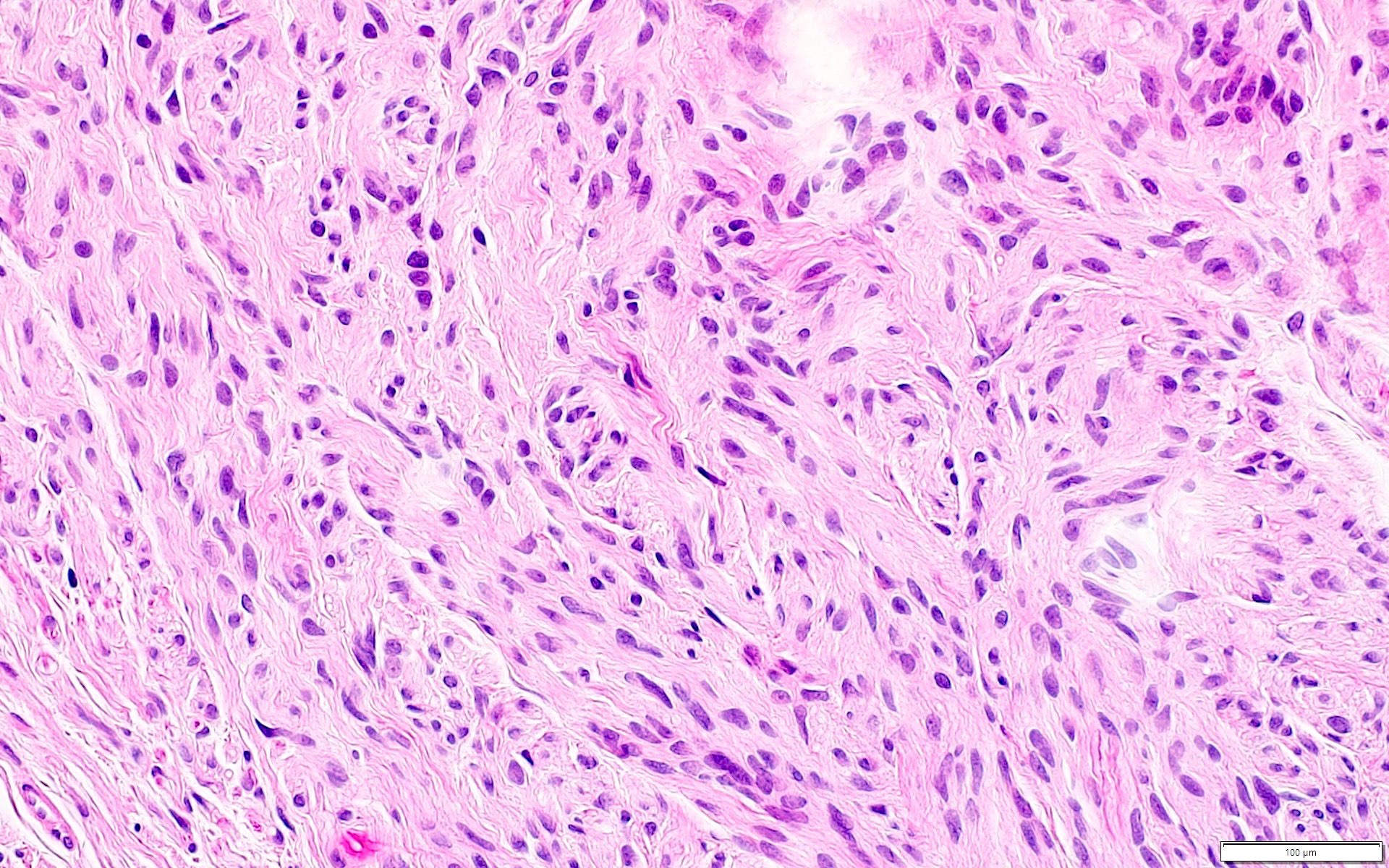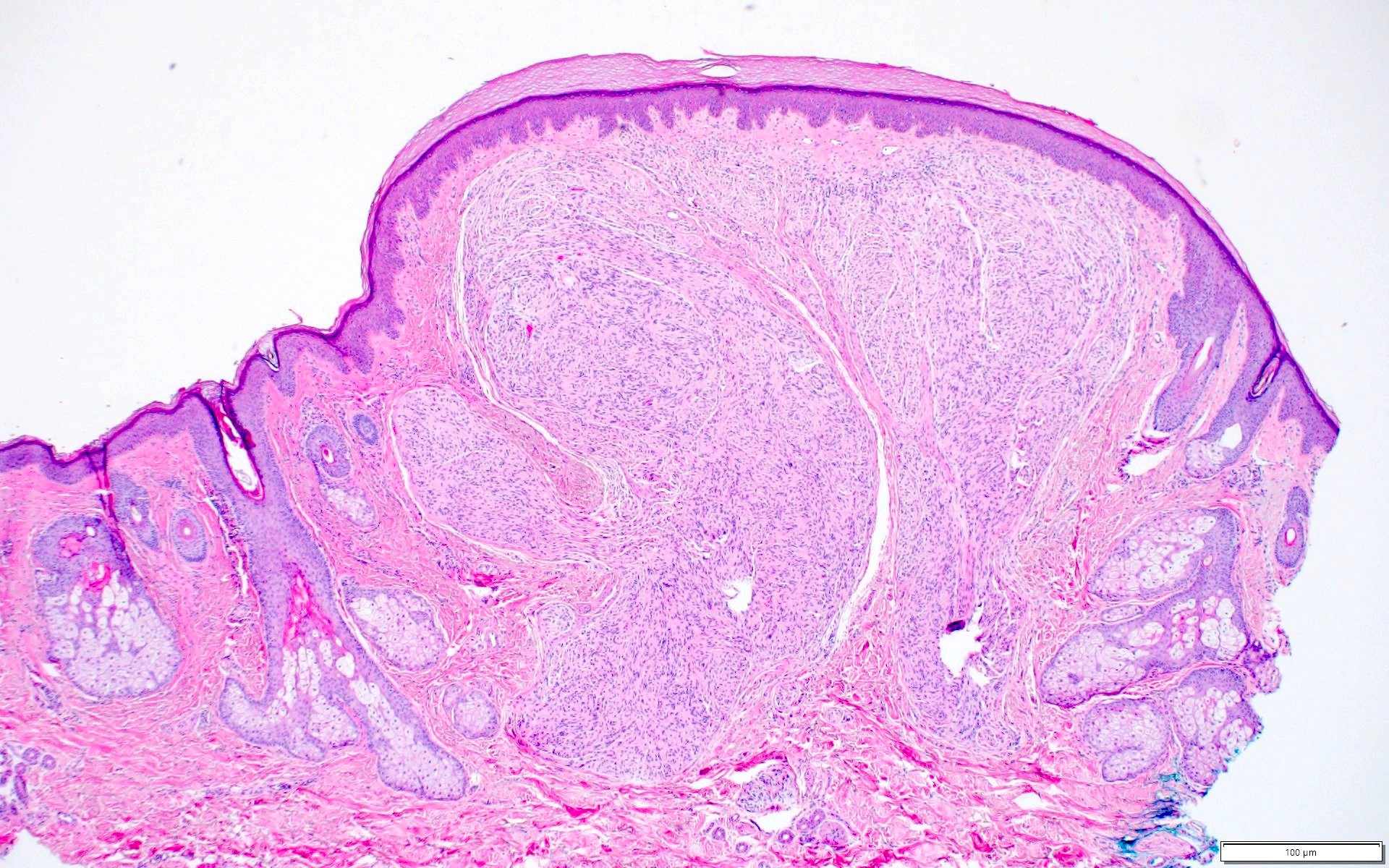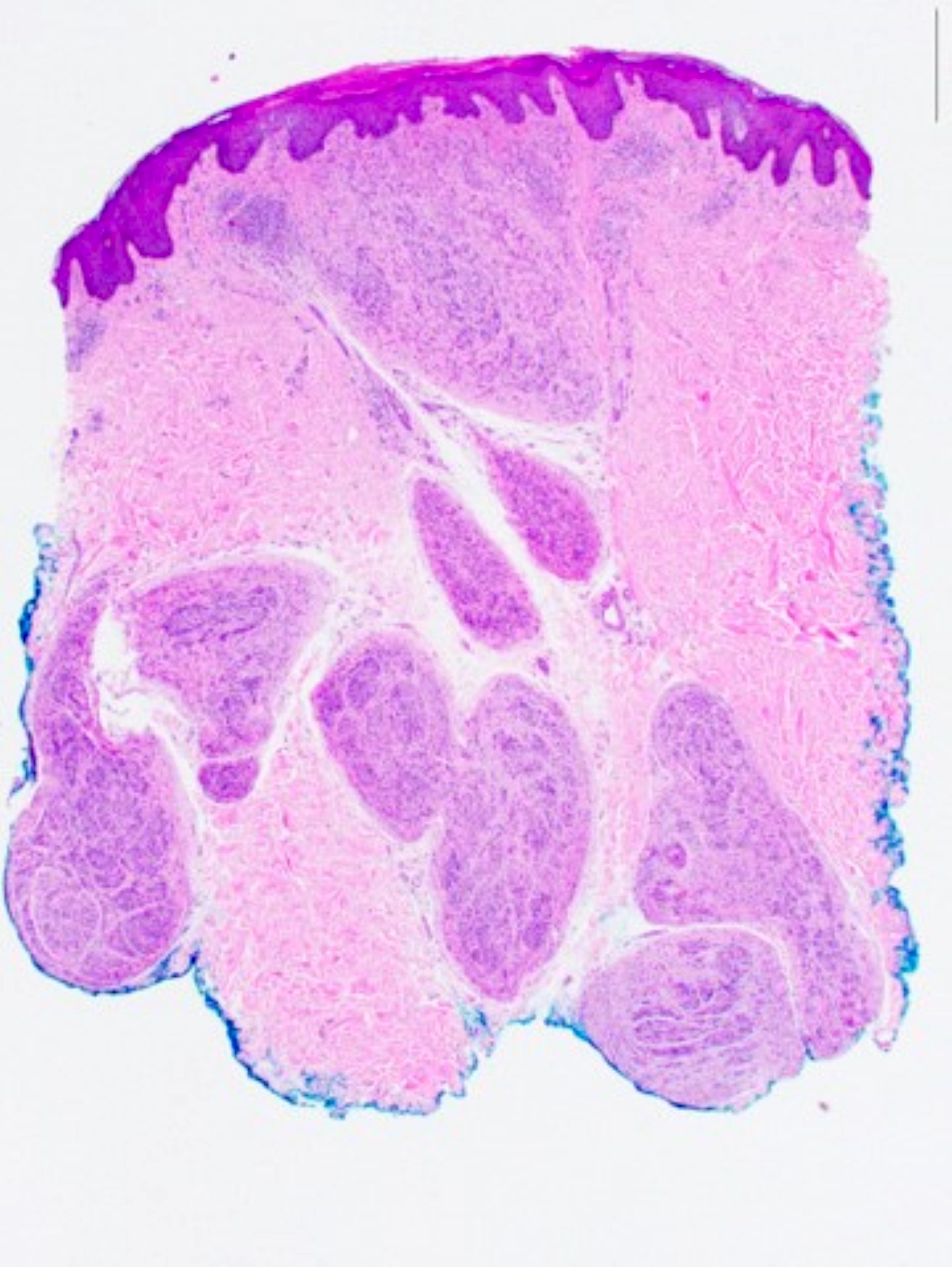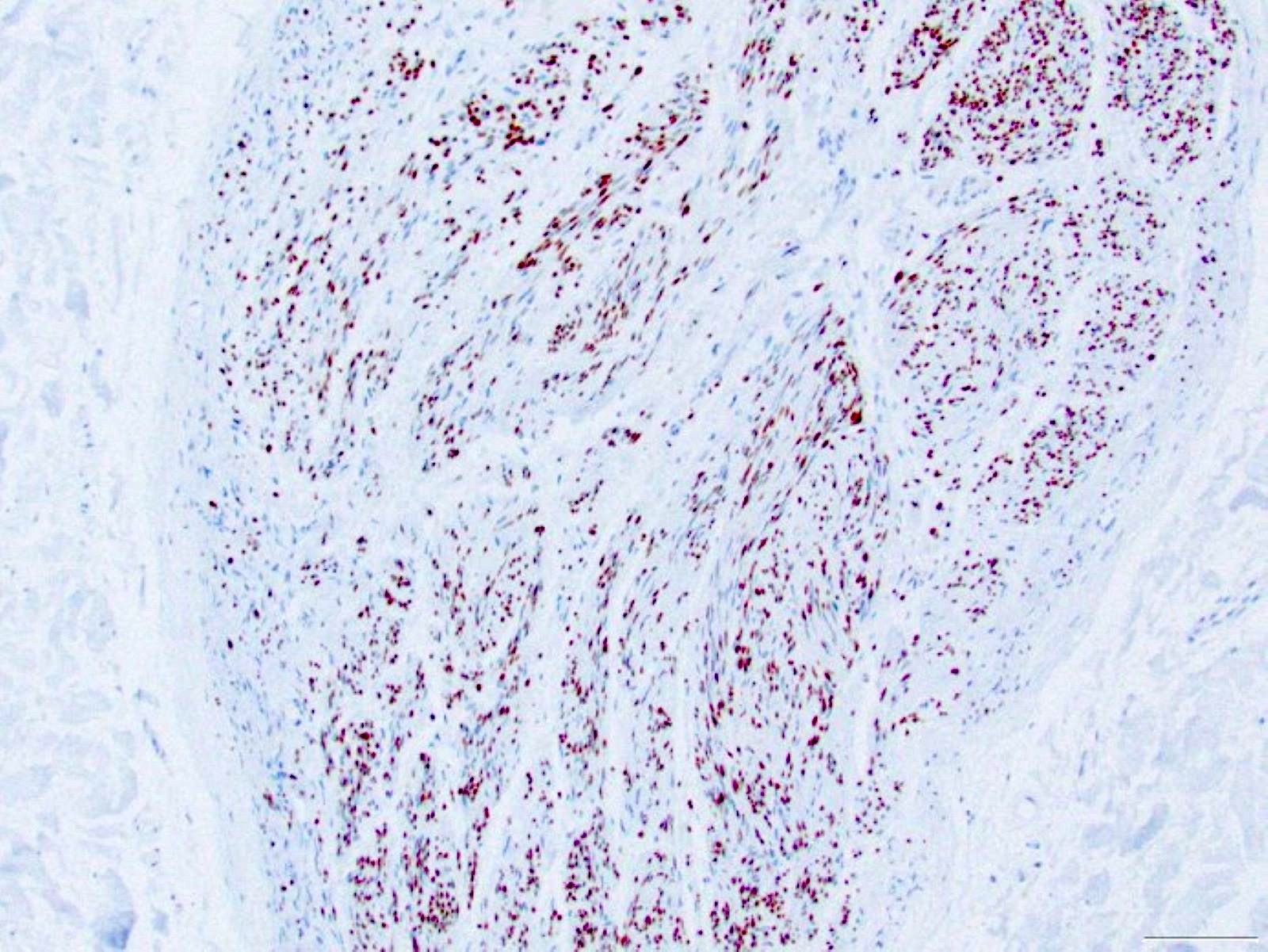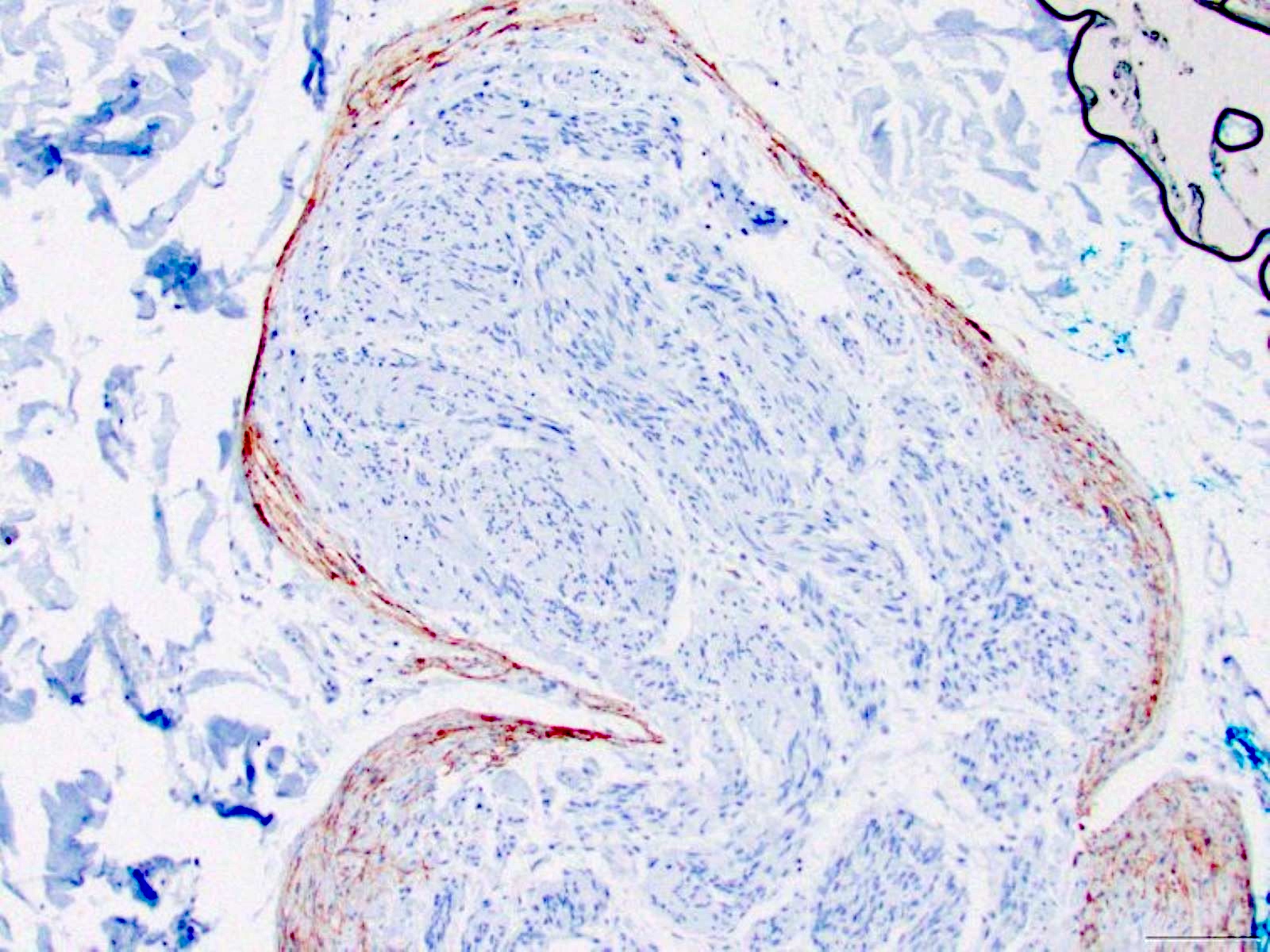Table of Contents
Definition / general | Essential features | Terminology | ICD coding | Epidemiology | Sites | Etiology | Clinical features | Diagnosis | Prognostic factors | Case reports | Treatment | Clinical images | Microscopic (histologic) description | Microscopic (histologic) images | Virtual slides | Cytology description | Positive stains | Negative stains | Electron microscopy description | Videos | Sample pathology report | Differential diagnosis | Additional references | Practice question #1 | Practice answer #1 | Practice question #2 | Practice answer #2Cite this page: Kunzler E, Rohr BR. Palisaded encapsulated neuroma. PathologyOutlines.com website. https://www.pathologyoutlines.com/topic/skintumornonmelanocyticpalisadedencapsulatedneuroma.html. Accessed September 18th, 2025.
Definition / general
- Palisaded encapsulated neuroma (PEN) is a benign, well circumscribed tumor consisting of Schwann cells and axons
- The term is misleading as nuclear palisading is not always present and the capsule may be partial or inconspicuous
Essential features
- Palisaded encapsulated neuromas are superficial dermal tumors, which often present as solitary lesions on the face or near mucocutaneous junctions
- Histopathologic features include a well circumscribed dermal tumor of bland spindled cells arranged in bundles
- Clefting is often seen between the tumor and surrounding dermis
- Palisaded encapsulated neuromas can be differentiated from schwannomas by their superficial depth and lack of Antoni A and B areas
- They can be differentiated from neurofibromas due to their fascicular arrangement and presence of clefting
Terminology
- PEN is also known as solitary circumscribed neuroma
- This name is preferred by some due to the misleading terminology of PEN
ICD coding
Epidemiology
- Most common in middle aged adults (Arch Dermatol 1972;106:865)
- No gender predilection
- Rare pediatric cases have been reported (Pediatr Dermatol 2014;31:e107)
Sites
- Lower face, near mucocutaneous borders and genitalia
- Occasionally reported on the trunk and acral sites
Etiology
- Usually sporadic with unknown etiology
- Rare cases diagnosed in patients with genodermatoses including Cowden syndrome and neurofibromatosis (Pediatr Dermatol 2017;34:e219, Int J Surg Pathol 2023;31:734)
Clinical features
- Usually a solitary, sessile, skin colored papule on the face (Indian Dermatol Online J 2018;9:262)
- Often asymptomatic and slow growing
- Rarely presents with multiple papules
Diagnosis
- Skin biopsy is required
Prognostic factors
- Recurrence rates are minimal after excision (Indian Dermatol Online J 2018;9:262)
Case reports
- 50 year old man with a solitary papule on the vermillion of the upper lip (JAAD Case Rep 2024;49:1)
- 50 and 56 year old women with left facial papules (Oxf Med Case Reports 2024;2024:omae003)
- 52 year old man with a papule on the glans penis (Dermatol Online J 2020;26:13030)
- 56 year old man with multiple skin colored acral papules (J Cutan Pathol 2022;49:82)
Treatment
- Benign; no treatment required
- Residual PEN can be observed or excised
Microscopic (histologic) description
- Well circumscribed superficial dermal tumor of spindled cells (Arch Dermatol 1972;106:865)
- Clefting is often seen between the tumor and dermis
- Spindled Schwann cells and axons are arranged in bundles with minimal atypia
- Occasionally, spindled cells are epithelioid or demonstrate nuclear palisading
- Occasionally, a thin, delicate capsule can be observed or dense fibrous tissue surrounds the tumor
- Stroma is variably myxoid
- Close association with adnexal structures in facial lesions
- Plexiform and multilobular patterns have been described (Int J Surg Pathol 2019;27:506)
Microscopic (histologic) images
Virtual slides
Cytology description
- Bland spindled cells with oval or elongated nuclei
Positive stains
- S100
- SOX10
- EMA: perineural cells
- Neurofilament: axons
- Reference: J Cutan Pathol 2022;49:82
Negative stains
- Cytokeratin stains
- SMA
- MelanA
- Reference: J Dermatol 2016;43:560
Electron microscopy description
- Axonal profiles and myelin density can be evaluated with electron microscopy (Arch Dermatol 1989;125:386)
Videos
Palisaded encapsulated neuroma
by Dr. Jerad Gardner
Sample pathology report
- Skin, chin, shave biopsy:
- Palisaded encapsulated neuroma / solitary circumscribed neuroma (see comment)
- Comment: There is a dermal tumor of bland spindled cells arranged in bundles. Clefting is observed between the tumor and surrounding dermis.
Differential diagnosis
- Neurofibroma:
- Peripheral nerve sheath tumor
- May be sporadic or associated with neurofibromatosis type 1
- May have ill defined or infiltrative margins
- Plexiform variant is essentially pathognomonic for neurofibromatosis
- Schwannoma:
- Encapsulated and well circumscribed tumor
- Antoni A areas with Verocay bodies and hypocellular Antoni B areas
- Less common in the superficial dermis than PEN
- Mucosal neuroma:
- Can be reactive / traumatic or associated with multiple endocrine neoplasia MEN2B syndrome
- Similar histopathologic findings to PEN, well circumscribed tumor of spindled cells arranged in bundles
- Leiomyoma:
- Traumatic neuroma:
- History of trauma
- May see dermal fibrosis / scar formation
- Histopathology shows haphazard nerve bundles in dermal fibrosis
- Neural hamartoma:
- Composed of tissues of mixed differentiation
Additional references
Practice question #1
A 55 year old man presents with an asymptomatic, 0.3 x 0.3 cm, dome shaped, skin colored papule on the chin. Histopathologic examination reveals a sharply circumscribed dermal nodule of spindled cells arranged in bundles with clefting. The tumor is positive for S100. What is the most likely diagnosis?
- Leiomyoma
- Neurofibroma
- Palisaded encapsulated neuroma
- Schwannoma
Practice answer #1
C. Palisaded encapsulated neuroma (PEN) is a benign spindle cell tumor commonly arising near the chin.
Answer B is incorrect because the findings of a sharply circumscribed tumor with clefting and bundles of spindled cells favor PEN over neurofibroma.
Answer D is incorrect because schwannomas contain Antoni A and B areas, while PEN lacks these features.
Answer A is incorrect because leiomyomas may demonstrate spindled cells arranged in bundles / fascicles but are S100 negative. Angioleiomyomas may be sharply circumscribed and encapsulated.
Comment Here
Reference: Palisaded encapsulated neuroma
Comment Here
Reference: Palisaded encapsulated neuroma
Practice question #2
Which of the following histologic features is most characteristic of palisaded encapsulated neuroma (PEN)?
- Clefting between tumor and dermis
- Collagen trapping
- Infiltrative growth pattern
- Presence of Verocay bodies
Practice answer #2
A. Clefting between tumor and dermis is a common histopathologic feature of PEN.
Answer C is incorrect because infiltrative growth pattern is not a feature of PEN.
Answer D is incorrect because Verocay bodies are observed within Antoni A areas of schwannomas.
Answer B is incorrect because collagen trapping is a feature of dermatofibroma.
Comment Here
Reference: Palisaded encapsulated neuroma
Comment Here
Reference: Palisaded encapsulated neuroma





